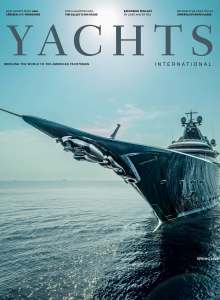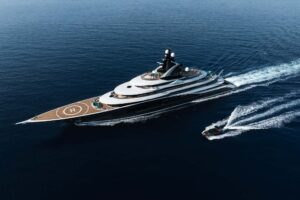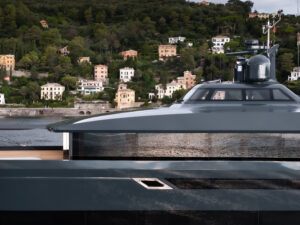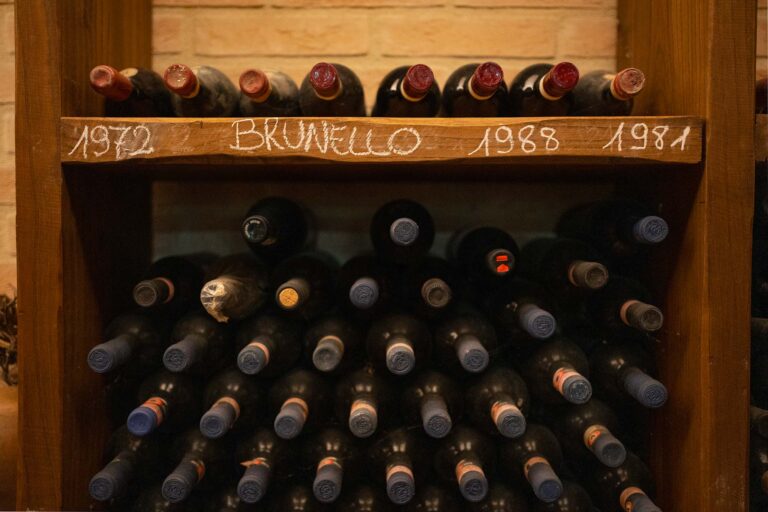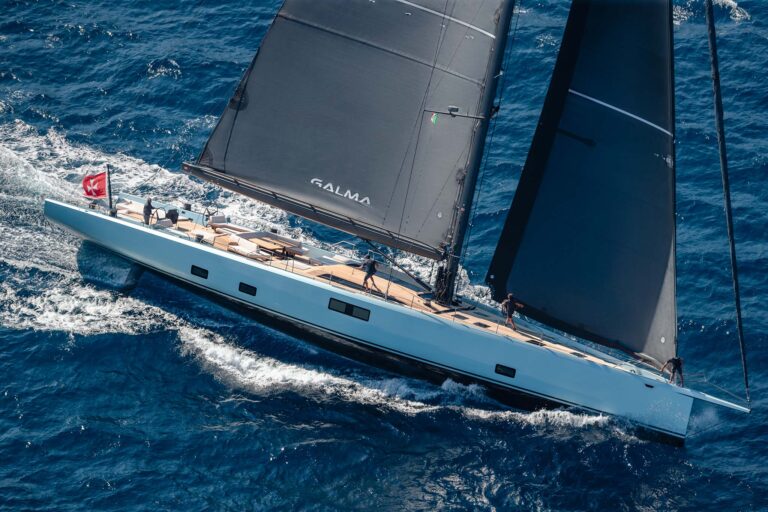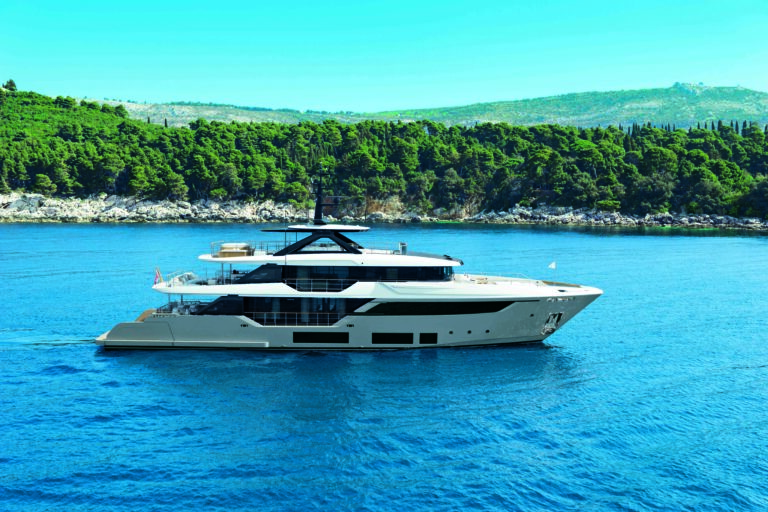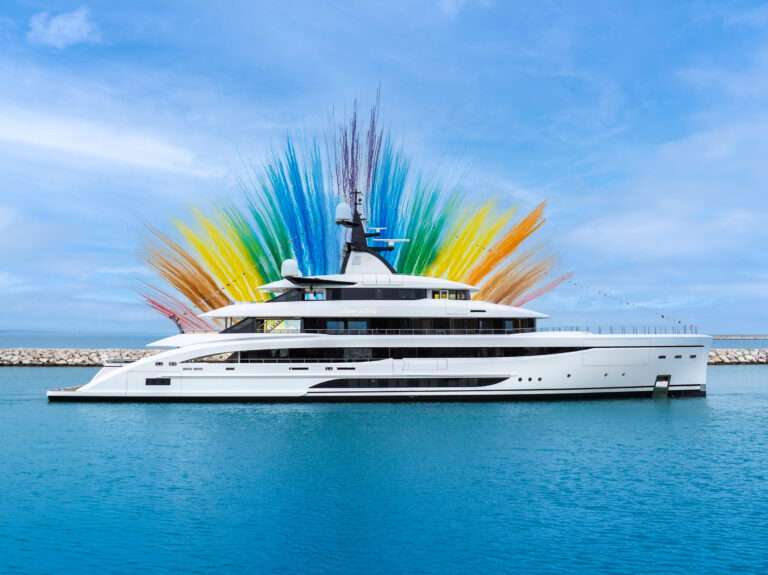Modern and sophisticated, Aquijo defines what a top-end sailing experience is all about. At 282 feet (86 meters) in length, Aquijo is the largest high performance ketch in the world.
A veritable tour de force, she is not merely a motoryacht with sails. Her 295-foot (90-meter) masts carry identical 12,830-square-foot (1,192-square-meter) mainsails (her designers call her a ketch, not a schooner). With all up including code sail, her total sail area leaps to a staggering 54,368 square feet (5,051 square meters). With all that horsepower, she proves a worthy and powerful performance sailing vessel.

Aquijo is the culmination of an unusual first-time partnership between two Dutch yachtbuilders: Vitters Shipyard and Oceanco. Vitters brought the sailing expertise and Oceanco the proficiency required to build a high-tech superyacht, Vitters did not have the facilities to accommodate such a large yacht, and Oceanco has long specialized in building complex vessels over 262 feet (80 meters).
“[The build] … was not a walk in the park,” says owner’s representative Patrick Moussa of Master Yachts. “But both builders played off their respective strengths, and we achieved the outcome we wanted.”
The project began in 2010. The owners had a clear vision of what they wanted: a high-performance sailing yacht that did not sacrifice the comfort and luxury of a superyacht. They own a 157-foot (48-meter) sailing yacht and have frequently chartered larger sailing vessels.
CLICK HERE to see the photo gallery.
“They chartered nearly every Perini available in the 164-foot to 189-foot range,” Moussa says. “Plus, they chartered 289-foot The Maltese Falcon several times, once for three or four weeks.”
The owners sought a yacht that would be comfortable and luxurious to live aboard for long stretches of time, and capable of around-the-world cruising. Safety, comfort and performance were the key words expressed in their brief and remained the mantra throughout the build.
Dölker + Voges, a design studio in Germany, collaborated with the owners to plan the interior spaces and create “the look” aboard. The owners wanted to feel connected to the sea and nature at all times. To that end, expansive windows provide natural light and help create an atmosphere in concert with the yacht’s surroundings.

“The yacht’s interior design is contemporary and elegant, yet fresh and natural,” says Robert Voges, partner in Dölker + Voges. “Clear and logical lines, pure materials and simplicity is what the owners wanted.”
Aquijo is also being offered for charter. Tom DeBuse, director of charter management at Y.CO, says, “Aquijo is replete with warm woods, white walls and pops of color exuding energetic contemporary cool throughout, complemented by an outstanding art collection.”
Tripp Design Naval Architecture, with offices in Connecticut and Amsterdam, won the bid for naval architecture and exterior styling. According to Moussa, much of the interior layout was already planned, and Tripp wrapped the exterior around the interior brief.
“Certain parameters were a given,” Bill Tripp says. “The yacht had to have a flybridge and a specially placed owner’s suite, and they wanted to feel comfortable when there were only two of them on board.” In effect, the owners wanted the ability to “turn off the lower deck” when no other guests were on the yacht.
When there is a full house, Aquijo has varietal space to suit everyone.
“The philosophy was to connect the different private and public areas in a logical order, creating multipurpose spaces,” Voges says, “and to illuminate with huge windows and full glass doors to create an exciting conjunction between interior and exterior areas.”


The engineering required to achieve the Aquijo vision was substantial, Tripp says.
“We were not creating a science experiment,” Tripp says. “We did not just do something new for the sake of it being new. Aquijo rests on the shoulders of many excellent sailing yachts before her.”
The key to the design was to get the rig loads right. “The rigging was premised so loads on the main and mizzen and jib sails would be similar,” Tripp says. “And these loads were targeted at a number we were comfortable could be safely handled. Everything had to be up-scaled for size and loads: shrouds, winches, jib sheets all had to be custom made.”
Oceanco, which has vast experience building large, oceangoing motoryachts, had to meet all the sailing yacht requirements.
“We were pushed to the limits of design and engineering to get everything in a finite space. Aquijo has half the volume of our 90-meter yachts,” says Erwin de Looff, project manager at Oceanco. “All systems had to work well at an angle, even the elevator. It was a challenge, but very interesting for us. I now have new respect for building sailing yachts and what it takes.” Oceanco adhered to its common build practices, and then some, the caveat being it had to focus even more on weight limitations than usual.
“On a sailing yacht there is obviously an extenuating level of concern,” De Looff says. “Solutions to minimize weight required meticulous calculations with all aspects of the construction. We had targets to reach on each and every detail of the ship’s systems.” Interior woodworkers, machinery suppliers and even hatch makers had to follow suit.


While Tripp and company were in charge of design, Moussa says, Master Yachts’ role was to keep the builders on track and ensure that all safety requirements were met.
“When we say watertight doors, we mean watertight. When we say build to be strong, we mean strong. This is not just a Cannes-St. Tropez boat,” he says. “She is designed to go around the world.”
The owners have mentioned going to Patagonia, the Straits of Magellan and various atolls in the South Pacific. With Aquijo’s steel hull and lifting keel, she is ready for almost anywhere her travels take her. She can also cruise relatively shallow waters. However, her exceedingly tall masts will prevent her from transiting the Panama and Suez canals, so she has to be strong and stable enough to weather a journey the long way around.
When asked why someone would want such a big sailboat, Tripp said a yacht Aquijo’s size would unquestionably ride out 40-foot waves in greater comfort than would a 164-foot (50-meter) yacht. He heard from the owners when they were in Greece last summer as a meltemi was blowing 35 to 40 knots. They reported Aquijo handled the weather and waves well.
Vitters brought its well-respected sailing know-how to the project, but Aquijo put that builder to the test, too.
“Even with the experience of more than 30 large sailing yachts, building Aquijo was a challenge,” says Louis Hamming, managing director of Vitters. “The sailing loads were all more than anything that has been seen on any other yacht. This meant customizing every part of sailing equipment on board, and in many cases inventing something new.”
Vitters also implemented a steering system it invented with feedback to the bridge, meaning it reacts to the load on the rudders. The load puts pressure on the wheel so you can feel which way to turn. On Aquijo, the distance between rudder and wheel is nearly 147 feet (45 meters), far greater than on most sailboats.
“From the first sea trial in the North Sea, we hoisted the sails and headed into the wind and it was easy to keep her there,” Tripp says. “We got right up to speed, doing exactly what she was designed to do.” She has the ability to sail closehauled at 40 degrees off the wind. “Aquijo acts in the same way that a sailing dinghy might act in terms of performance, acceleration, the feeling of the actual sailing and ease of handling of sailing systems,” Hamming says.“Her performance in all wind conditions makes her ideal for both daysailing and ocean passages,” adds DeBuse, who is hoping to entice clients seeking some sport along with a luxury charter. “We have been pleasantly surprised by the significant interest we have received from clients who have only previously chartered motoryachts.“
Combining the comfort of a superyacht and the thrill of real sailing, Aquijo has indeed raised the bar.
CLICK HERE to see the photo gallery.
***
Aquijo By The Decks
Aquijo’s guest spaces include a flybridge, bridge/owner’s deck, main deck and lower-deck beach club.
The flybridge has seating next to the helm for those who want to be close to the action. Aft on this deck is a Jacuzzi surrounded by sunpads, as well as a lounging and dining area with sofa seating. In keeping with sailboat traditions, the dining tables are gimbaled so drinks won’t spill when the yacht is heeling.
The bridge deck, a half-deck below the flybridge, comprises the captain’s cabin to port and the owner’s stateroom to starboard. The master suite has access to a private aft deck with lounges, a gimbaled dining table and a bar. Aft on this deck are twin staircases down to the main deck.

On the main deck are the salon and indoor/outdoor bar with seating for 12, beer on tap and a retractable television overhead. There is dining capacity for as many as 20 guests. The roof retracts for starlit dinners, and multicolored lighting enhances the entire area. Two horseshoe-shaped sofas overlooking the ocean are perfect for barbecues. One of the most stunning features is an in-deck skylight that peers down to the Jacuzzi in the beach club on the lower deck.
Steps lead to beach club/spa area. Here, there is easy access to the water through an aft exterior door. The U-shape sofa on the starboard side creates a pleasant lounging area. On the port side are a steam room and sauna.

Aquijo accommodates 12 guests in seven staterooms, including the master suite. She also has two VIP suites, each of which can convert into two separate staterooms, one double tailored for guests with disabilities, and one twin. There are also two convertible lounges on the main deck, and a guest elevator. Each stateroom is differentiated by a bold color scheme, and all have an uncluttered modern feel with textured wood walls, leather and stainless steel trim, and ocean views. In keeping with an au naturel spirit of a true sailing yacht, there is no TV or audiovisual system in any of the guest staterooms.
The foredeck has a settee where guests can enjoy the sailing experience while seated below Aquijo’s headsails.
CLICK HERE to see the photo gallery.
***
Vessel Specifications
LOA: 281ft. 10in. (85.9m)
LWL: 268ft. 9in. (81.9m)
BEAM: 47ft. 6in. (14.5m)
DRAFT: keel up, 17ft. 4in. (5.23m); keel down, 38ft. 1in. (11.6m)
CONSTRUCTION: steel hull, aluminum superstructure
GROSS TONNAGE: 1,540
ENGINES: 2 x 1,810-hp Caterpillar 3512s
FUEL: 26,945 gal. (101,998L)
WATER: 9,510 gal. (35,999L)
SPEED UNDER POWER (max.): 17.5 knots
SPEED UNDER POWER (cruise): 14 knots
SPEED SAILING: up to 25 knots
SAIL AREA: 40,902 sq.ft. (3,800 sq.m.), with code sail 54,368 sq.ft. (5,051 sq.m.)
CLASSIFICATION: Lloyds 100-A1
NAVAL ARCHITECTURE: Tripp Design Naval Architecture
EXTERIOR DESIGN: Tripp Design Naval Architecture
INTERIOR DESIGN: Dölker + Voges
GUESTS: 12 in 7 staterooms
CREW: 17
BUILDERS: Oceanco and Vitters Shipyard
YEAR: 2016
For more information: oceancoyacht.com, vitters.com

